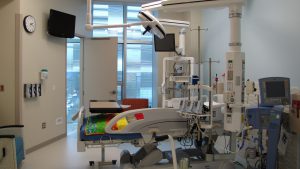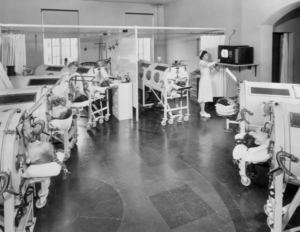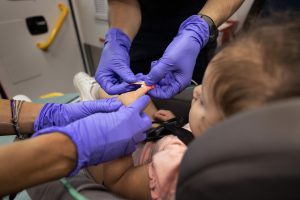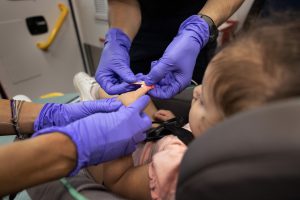To imagine the pressure felt in American intensive care units over the course of the pandemic, it is perhaps helpful to think of a rocky mountain range.
The peaks have been pointy and difficult to summit. Even the valleys have been placed high on the sierra, some higher than others. Until recently, the contours of the Covid-19 experience in pediatric ICUs spooled out over more gradual slopes.
While their infrastructure and staff have certainly felt the pandemic’s industry-wide shake, far lower hospitalization rates amongst younger Americans helped limit the pressure PICUs have been put under.
Since early last year, more than six million Americans aged 18 or younger have tested positive for Covid-19. Of those, less than two percent (around 120,000) required hospitalization; a rate five times lower than adults.
The PICU is the last line of defense for children, but the system is not designed to take on this magnitude of preventable illnesses.
Like much in 2021, Delta changed things up. The highly virulent Covid-19 variant has enjoyed a productive summer amongst young Americans. Though hospitalization rates didn’t change, higher infected numbers meant far more youngsters required intensive care.
At its high water mark, more than a quarter of a million positive cases—around 5000 new hospitalizations—were recorded amongst those 17 and younger in the last week of August. As recently as the first week of October, there were around 148,000 positives, producing nearly 3000 new pediatric intensive care patients.
The surge created a generational stress test of the American PICU system. States like Texas, Alabama, and Oregon saw pediatric units hit capacity, prompting a flurry of news stories and a degree of focus uncommon for the system.

“The average pediatric ICU in the [United States] has 12 beds,” Dr. Christopher Carroll, a pediatric intensivist at Connecticut Children’s Medical Center, told the New York Times on September 9.
“In a system that small, even a few patients can quickly overrun the capacity. And there are fewer specialty-trained pediatric clinicians to pick up the slack.”
Initially set up in response to another highly viral epidemic in the 1950s, American PICUs have largely held firm against the Covid-19 challenge.
The impacts of political divisiveness, inconsistent school masking mandates, and a vaccination rollout to reach all age groups are hard to ignore. However, the potential lessons are still left to learn.
The legacy of the iron lung
By the mid 20th century, poliomyelitis—polio—loomed as one of the biggest fears held by American parents.
Primarily spread through unhygienic contact, polio’s most severe forms would lead to paralysis and death. Amongst other measures, its avoidance saw localized social distancing and quarantining of families with infected members.
“Late summer was dubbed ‘polio season,” NPR reported, in 2012. “Public swimming pools were shut down. Movie theaters urged patrons not to sit too close together to avoid spreading the disease. Insurance companies started selling polio insurance for newborns.
“The fear was well-grounded. By the 1950s, polio had become one of the most serious communicable diseases among children in the United States.”
The high water mark came in 1952 when 3145 American children died of polio. Of the 57,879 that had contracted it over the past twelve months, nearly 37 percent suffered “mild to disabling” paralytic poliomyelitis.
In 2021, 2901 med students became pediatric residents in the United States. Most will spend time in a PICU.
The same year, a team led by American virologist Jonas Salk created the first effective polio vaccine at the University of Pittsburgh. Over the next decade, nationwide vaccinations virtually extinguished polio in the United States.
For those whom the vaccine wasn’t able to help over the preceding decades, a range of proto-intensive care measures was undertaken to care for them.
Images of rooms full of children in bulky ‘iron lungs’—negative pressure ventilators that aided respiratory systems—best captured those attempts, but the first pediatric intensive care quickly evolved from there.
The first dedicated PICU was opened at the Children’s Hospital in Goteborg, Sweden, in 1955. Ten years later, the first American PICU was established at the Children’s National Hospital in Washington, D.C.
Pediatric anesthesiologists played a crucial role in the early establishment of intensive care for children; Dr. David Epstein and Dr. Judith Brill wrote in Pediatric Research in 2005. Many took early leadership roles in American PICUs.

“These anesthesiologists were the first to transfer principles of infant and pediatric physiology and pharmacology from the operating room to the ICU and the first to care for critically ill infants and children outside the operating room.”
Though the threat of polio was gone, continuing improvements in pediatric surgery—saving patients from conditions that would have previously led to death—meant PICUs spread across the U.S.
By 1995, there were 306 pediatric units with an unknown number of beds. There are now around more than 400 with 5115 beds in total. Temporary and makeshift PICUs have contributed to that number over the last year and a half.
In 2021, 2901 med students became pediatric residents in the United States. Most will spend time in a PICU.
‘The PICU is the last line of defense for children’
The first national headlines showing the impact of Delta in PICUs began arriving in mid to late August. More than 750,000 young Americans contracted Covid-19 in the coming month. Two-week spells in PICUs were common, delaying a quicker turnaround in beds.
“Increased transmission, not a deadlier virus, helps explain why pediatric wards are more crowded now than they were earlier in the pandemic, and shows that even a low-risk disease could lead to many deaths if enough children catch it,” German Lopez wrote in Vox last week.
Texas was the worst hit. By mid-August, Houston and Fort Worth PICUs were near capacity, while the rest of the state suffered badly, too. Oregon, Florida, Alabama, Tennessee, and Louisiana were amongst other states hit hard.
While a unit in Kansas City was overwhelmed with patients, a unit in Chicago had not seen a Covid-19 patient in the PICU in six weeks. Our own experiences mirrored the inequities in the Covid-19 disease burden throughout the country.
“In Dallas, we have zero ICU beds left for children,” Dallas County Judge Jenkins told media on August 13.
“That means if your child’s in a car wreck, if your child has a congenital heart defect or something and needs an ICU bed, or more likely if they have COVID and need an ICU bed, we don’t have one. Your child will wait for another child to die.”
“PICUs in some areas became full, and we started using connections to find placements for kids who needed critical care but whose local hospitals were out of space,” eight PICU doctors wrote in a stirring nationally syndicated column in early September.
“But this was not true everywhere. While a unit in Kansas City was overwhelmed with patients, a unit in Chicago had not seen a Covid-19 patient in the PICU in six weeks.
“Our own experiences mirrored the inequities in the Covid-19 disease burden throughout the country.”

Stifled by remote learning and social distancing in 2020—the same factors led to a “substantial” decrease in PICU admissions early on—a resurgence of respiratory syncytial virus (RSV) has provided a parallel epidemic to manage.
Doctors have called on school districts to bring in mask mandates beyond sixth grade to lessen infection numbers and call for an urgent upping of vaccination rates across the board. Currently, the CDC is recommending vaccinations to anyone 12 or older.
“The PICU is the last line of defense for children, but the system is not designed to take on this magnitude of preventable illnesses,” they wrote.
“This is what haunts us: the reality that we might not be able to care for every child who needs us. We are pro-vaccine, pro-masks and pro-child.”
‘This is all preventable’
While Covid-19 foothills are being reached again in PICUs, newer strains show the virus’s bite remains sharp.
“As the fall approaches and more children return to full in-person learning, we will inevitably see further spikes in pediatric hospitalizations and PICU admissions,” Dr. Uche Blackstock, an emergency physician, and chief executive of Advancing Health Equity, wrote in the Washington Post on September 2.
Tens of thousands of American children have lost a caregiver due to Covid-19, which may create enduring health complications.
The context of the pandemic’s current death toll is important to mention. According to yesterday’s CDC stats, 513 Americans aged 17 or younger have died of complications from Covid-19. More than 195,000 aged older than 85 have.
As the virus becomes endemic, future generations might be regularly exposed to SARS-CoV-2 at a young age .. but children’s natural defenses are likely to crush it.
Experts say the reasons behind that difference will provide us with a long-term direction away from Covid-19.
“… [E]xperts, on the whole, are optimistic so far that children’s natural defenses against the virus have held up,” Lopez wrote.
“That resilience isn’t just good news for parents; it’s a hopeful sign for the future of Covid-19. As the virus becomes endemic, future generations might be regularly exposed to SARS-CoV-2 at a young age.
“But children’s natural defenses are likely to crush it, building immunity, piece by piece, that could help shield them for a long time. Coupled with the vaccines, the generational buildup in natural immunity could, over time, defang the virus.”



